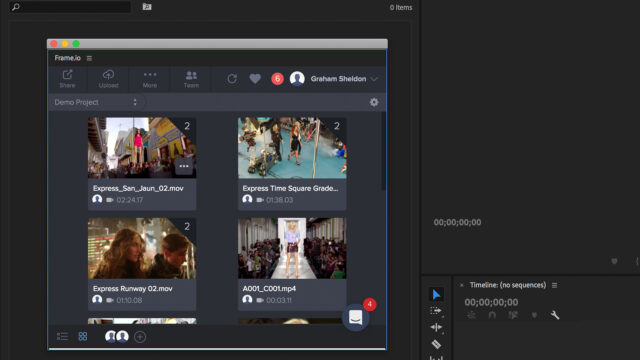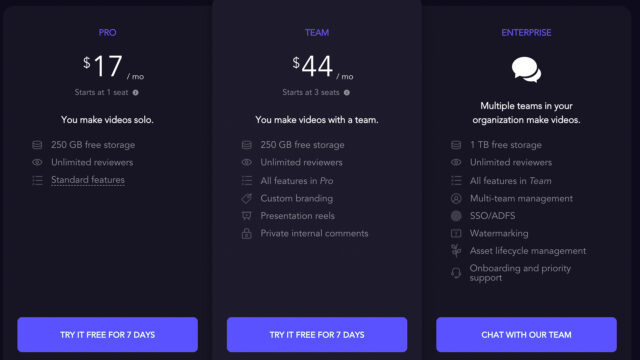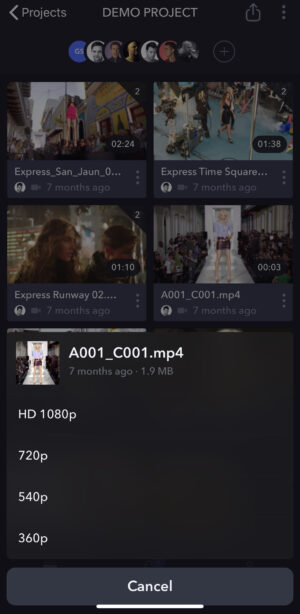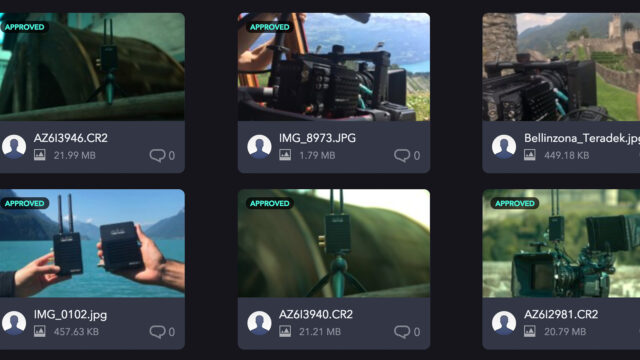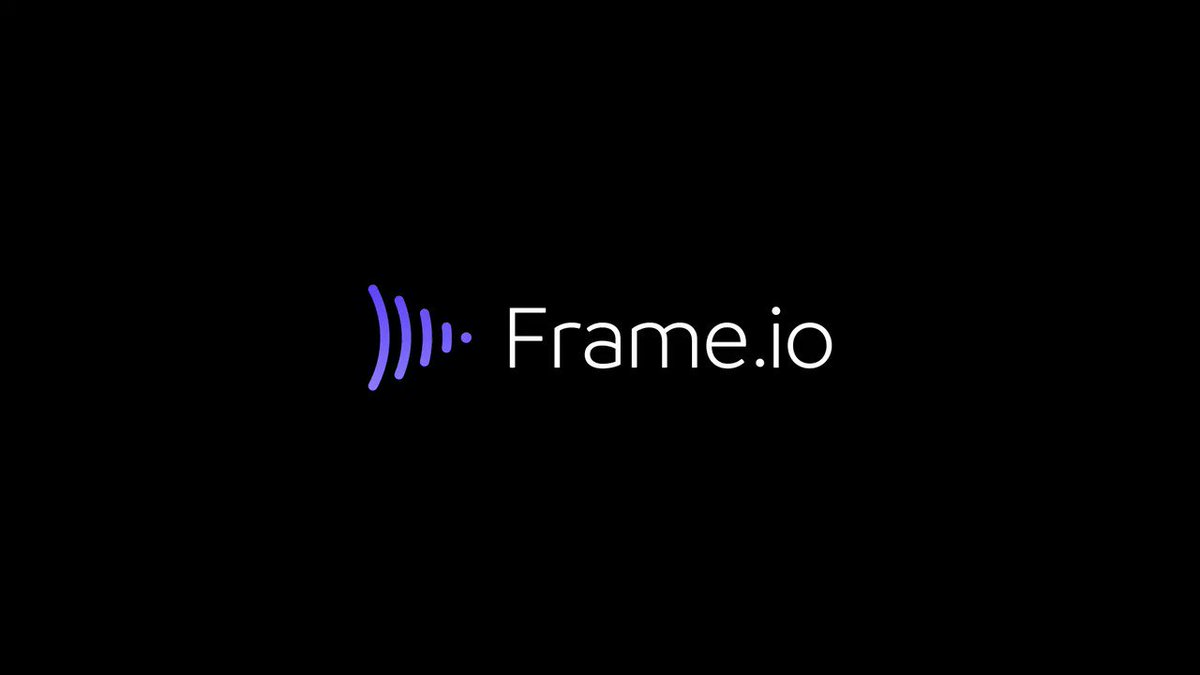
I resisted using Frame.io for some time. Did I really need another application in my life? Could it really be worth switching everything over and having my team learn a whole new platform? Frame.io had initially caught my attention at NAB last year. My producing partner (Rin Ehlers Sheldon) and I were given a demo, and afterward, we were both strongly advocating for the interface to win one of cinema5D’s “Best of Show” awards. It also took home awards from just about every publication and the exposition itself.
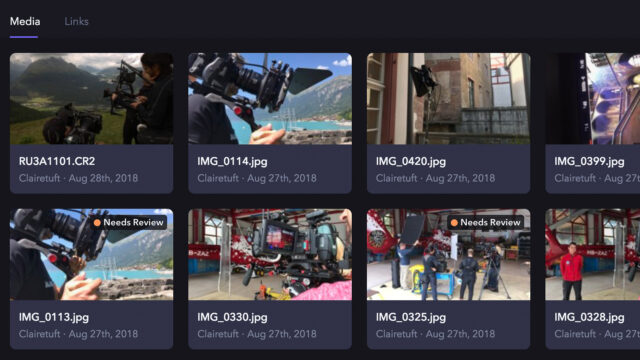
At that point, our company had a busy year ahead with huge post-flow headaches looming over us. Rin and I had a personal mission for NAB 2018, and it was to find affordable innovations that would ward off those headaches for our small company. On the docket was 6 hour long episodes for a documentary series and 12 episodes of a digital series, both shooting in 8K on Red Monstros and Heliums. We needed organization and retention. Above all, we needed a way to access and communicate with our teams while traveling. For us this meant coordinating between 6 editors and a slew of stakeholders and collaborators giving notes. Frame.io claims this is what sets them apart. After all, it was designed by post production pros who were fed up the tedium and frustration of failed uploads or hours of babysitting Vimeo queues. They knew there was a better way for the exchange of notes and content, and they set out to perfect it: the exact solution to our exact problem. It seemed too good to be true. Read on to see if it was.
What is Frame.io?
Frame.io bills itself as “solving video review and collaboration.” It does this by giving multiple teams and viewers access to browser based project folders filled with a variety of your core assets, such as exported video drafts or images. The user can stack different exports of the same project to keep track of version history. Versions can even be played side by side for comparison. It accepts any and all media file types that can be organized into a folder structure, one that should feel familiar to both PC and Mac users… really anyone who has used a computer ever. (Editors may chuckle, but this intuitive structure is helpful when collaborating with less tech savvy clients and investors.) Frame.io encodes your video to HTML 5 for browser video playback, but it saves your core file for download at anytime without compression being introduced. This is HUGE as other online video services have a tendency to compress to the point where things might get pixelated or blacks get noisy once live and they’ll even destroy your color grade on occasion (cough,Vimeo, cough, cough). The most alluring advantage offered is their proprietary upload tech.
Their uploader slices your file into 20 MB chunks and uploads them concurrently in batches of five, resulting in a much faster upload that can be paused and resumed, even if your computer loses internet access, your drive gets unplugged, or your laptop turns off. This is where the company’s origin story really shines through. It’s something only editors really understand. Anyone working with 4K resolution or higher or who has had to upload content from remote locations knows what a lifesaver this is.
The Definitive Guide to DaVinci Resolve
Getting Started
Diving into Frame.io is painless in my experience. Create an account, select a plan, create a project, then invite your team members to collaborate. Number of team members may be limited based on the level of plan you purchase. Determine what level of access and editing power each person has: whether or not they should be emailed as the project is updated, whether you want to be notified when they give notes, or if they’re allowed to upload/download content. There is a distinction between collaborators and team members, which you can read about here.
Download the app for phones and tablets, as well as correlating NLE integration. We’re Premiere CC users at our company, so we installed the free Premiere plugin for Frame.io, which our editors love. After the plug-in is installed, head to Window -> Extensions -> Frame.io and your new Frame.io window pops up with your current project visible (see the above image). This integration allows you to set up watch folders for a timesaving peace of mind. Frame.io also offers plugins for Final Cut X, Adobe AE, Avid Composer, Slack, Vimeo and Watch Folders for macOS.
Giving Notes
Giving and taking notes can be tricky. The ability to give clear and concise notes without eliminating agency or enthusiasm is a real art. The mode of delivery can also be an issue. When notes start being delivered via text message, a personal detestation of Frame.io founder Emery Wells, lines can be crossed in all sorts of places. What’s on the record? What’s off? Disrespect of an editor’s time (or anyone’s, for that matter) accompanied by the blurring of expectations for when your team members are on and off the clock is major consideration most producers and directors need to make. An email of 500 notes in a list can be demoralizing and can often lead to a break in your editor’s pace that is now entirely avoidable.
Additionally, all parties work more effectively in specificity, so it is very clear for one side how to take notes and very clear to the other side when they have been taken. Errors in feedback cost money and time in the midst of a busy production schedule. Nothing frustrates a producer like giving the same note twice, and nothing infuriates an editor like working on something for hours that ends up getting changed or cut. Everyone needs to know which way to row, so the boat doesn’t spin in circles. While Frame.io won’t necessarily make your captain more decisive or magically engage your team in some fulfilling reciprocity, it does remove a great deal of the common obstacles that prevent your ideal post “atmosphere.”
As the content plays in a review window, one simply has to start typing a note when so inspired, and the playhead will drop a marker at the exact point where it’s needed. At this point, the viewer can even utilize a pen tool to draw on the frame for the most visual note possible. Did you catch a corner of a boom pole in your frame and need it masked out? Circle it! Need an asset moved to the left? Draw an arrow! Obviously, timecode is a given at the moment the note is typed, which is incredibly helpful. With the integration into Premiere, the markers will even drop right onto your editor’s timeline, so there’s no need to open and close the browser. Frame.io will also email you (depending on your settings) when a collaborator or team member has commented, updated, or changed something, a feature I am particularly fond of.
(There is currently not an option for in and out points to define a range of timecode, but Frame.io says us this feature is coming. At present, you have to write IN and OUT in two notes, which is a little obnoxious, but having the desired changes tied to exactly the right moments is still a better option than an emailed communication of the same thing. My guess is this wasn’t a priority because editors hate blanket notes, but they are necessary from time to time.)
Post Issues fixed by the Frame.io Interface
- One party could be referencing an old version and giving incorrect timecode.
- Tasks/notes are dropped because a note is buried on a 100 count email thread.
- Two notes are in conflict with one another and the editor or post team isn’t sure which to take.
- One party gets annoyed because a note wasn’t taken prior to going live. You now have a written history on if this did or didn’t happen with the exact time in print.
Pricing
Here is really the biggest drawback, and it’s not a small one.
Look, I’m not saying it’s not worth it. They’ve done a great deal of work to give us something we really need, but if you are used to paying $34 for a Vimeo Pro Unlimited membership, which allows for 3TB/year and unlimited weekly uploads, you’re going to have major sticker shock switching to or adding Frame.io. It feels like a pretty big kick to the gut for those of us that aren’t Buzzfeed, BBC, VICE, etc, because if you’re working with high res content, which most of us are, 1TB of storage isn’t going to last.
When I pay for a subscription for my business, I don’t want to have to choose between which projects I put on this new great platform and which team members get to use the better tool. The only factor I want determining how many projects I’m working on at a time is my own ambition, not my app’s limitations. I find it a little hard to stomach paying a comparable amount to what I spend for my company’s Creative Cloud Subscription that gives me multiple apps for actually creating the work. Most reading this would likely opt for the tier that allows a small team of three for $44/monthly or a single member team subscription at $17/monthly. The Frame.io rep at NAB last year talked to us about scaling back membership at times you have less collaborators, but this isn’t really an option if you’re working on a feature or another long-term or large scale project. It’s not a realistic option for most companies… most likely you will sign up at one tier and either stick with it or upgrade. It’s just the nature of the beast.
That being said, if it really came down to cost, I would cancel my Vimeo before I let go of Frame.io, because once you’ve had the advantage, you won’t want to work without it ever again. Add in the ironclad file encryption, the use as a final delivery service, the lack of compression, along with being able to use this platform in pre-production for the exchange of storyboards, design renderings, etc and you’ll find the two services aren’t even really comparable.
Mobile Version
The award-wining Frame.io iOS app is free and intuitive. As a producer, I use the app more frequently than the site. Managing the post of multiple projects across different teams within the app’s clean and efficient UI design has saved me a great deal of time. I use the “Save to Camera Roll” feature frequently to review for flights or to transfer to social media in a pinch.
There is one odd quirk of the Mobile version currently tied to sharing your work.
There are two option in sending off your content from Frame.io. Sharing a “Presentation” provides a link where you can view but can’t give notes. This option can be sent to any email address, quite helpful when you need to extend viewing outside your network of Frame.io users. Sending a “Review” link, with which note giving is possible, is limited to those who have created accounts on Frame.io. Here’s where the quirk comes in. When I go to send a Review, I follow the prompt to”Add Recipients.” Whatever name I type, greets me with that first name I typed–followed by a list of all the users on Frame.io that contain the name I typed. Meaning if you are trying to send a link to Ben Hasselblad, after you’ve typed ben, you will have access to Ben Freud, Ben, Howard, Ben Pitt, Ben Garcia…you get the idea. These are real names of real people, not social media handles. This is a privacy concern in my opinion. If one were a career-hungry camera op, he or she might get the gumption to send the old reel out to anyone that comes to mind (and also has a Frame.io account). I reached out to Frame.io about this, and this is how they responded:
“When adding Collaborators via the iOS app, it will show the different options for people, similar to social networks. Per requests that have come in, we are reducing this to display only people that have already been added as Team Members or Collaborators within the account. This will be adjusted on the web app soon. I don’t currently have an ETA when it will be adjusted on the iOS app, however, we have many updates for the iOS app coming soon as well.” – Frame.io Team
File Delivery
As I mentioned earlier, the ability to deliver the final un-compressed file to the end user or client is a big draw. With other services (Dropbox *cough) I’ve had issues uploading lengthy video files over 8gb and I’ve experienced none of that here. With the $44/monthly and above plans, you are also able to customize the client review window with your company branding and color scheme — which is another nice touch.
Cons for delivery:
There is an aqua color cast on RAW stills in the Frame.io window. This does not remain when the files are downloaded, but it is a problem if you are a photographer using the system for review with your clients. Of course, you can just choose not to upload RAW images, but if you want review and delivery to be in the same place, it may not be an attractive explanation for you to give to your clients. When I asked, the Frame.io team said my browser was causing the color cast. Frame.io sent me a comment on this:
“.CR2s won’t be absolutely color accurate since Frame.io is creating the browser-friendly version as a .jpg. Also, each browser would display it differently too.” – Frame.io Team
I had one project that involved uploading hundreds of images to Frame.io for review and we labeled each “In Progress, Needs Review or Approved”. You are able to sort by status, but not filter. That means I still end up scrolling through hundreds of photos to get to the clump categorized as “Needs Review.” Photos are not the main pull to Frame.io, but if this is truly to be a one-stop shop, there’s some progress to be made with different types of file organization. Not an issue when you have five assets in a single folder, but definitely an issue when we’re talking about assets in the hundreds to thousands.
All in All
Frame.io streamlines the note giving process with innovation and efficiency. The application has made a strong case for being a singular workflow interface, and they are nearly there. Frame.io solves problems I didn’t even really know I had. After utilizing its features in post production over the last year, my company won’t be going back to the TL;DR days of bullet point laden emails and countless back and forths containing the phrase “Did you mean…” With the very few criticisms my team and I have of Frame.io, we unanimously find it an invaluable tool. This is a company that is innovating in leaps, not steps–and we can’t wait to see what updates that implement next.
Have you used Frame.io in the past? Comment below!



